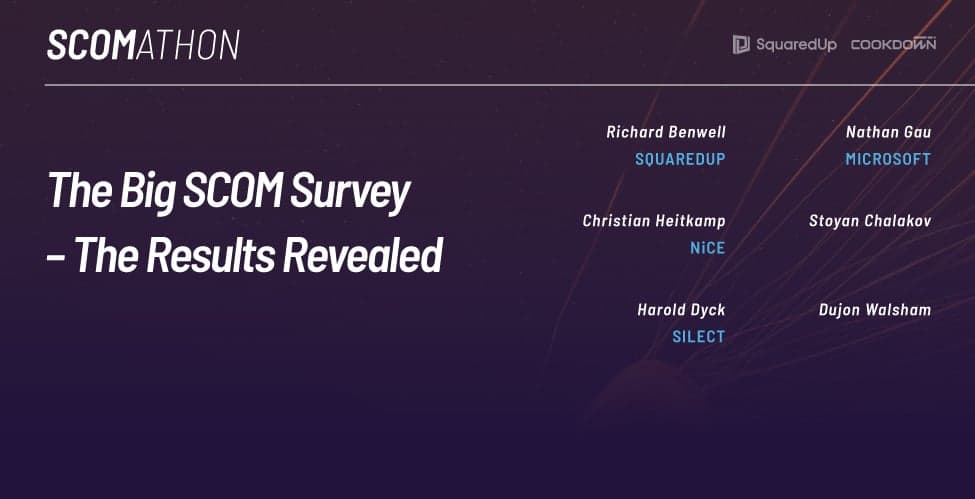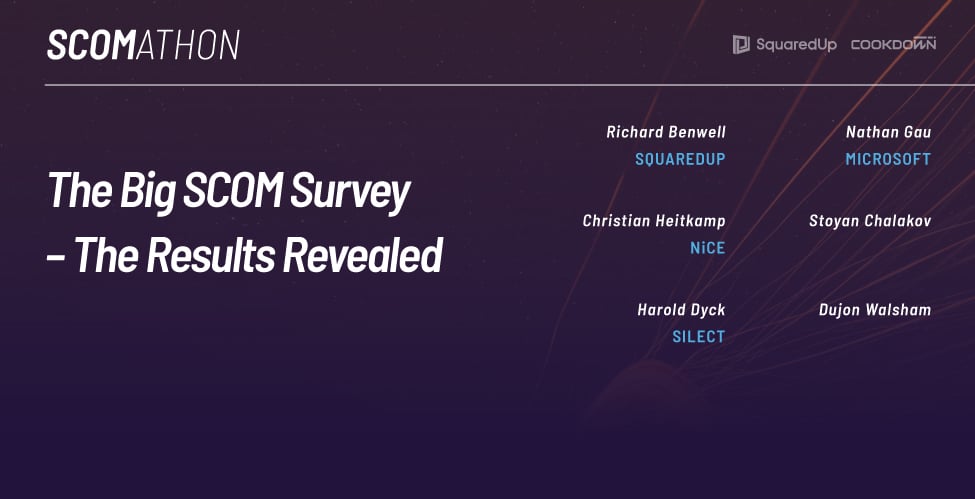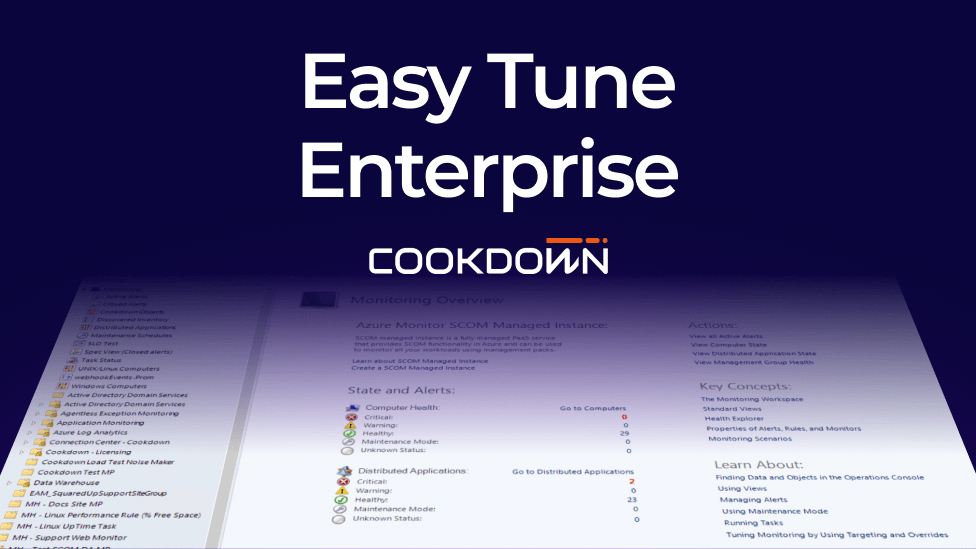
The Big SCOM Survey: Results and expert analysis
What’s the future of SCOM? How do others set up their SCOM landscape? What tools are SCOM Managers using to help streamline processes?
The answers are all here.
The Big SCOM Survey 2021 is the first of what we hope to be an annual survey where we measure the pulse of the SCOM community, get insights and share best practices. This year, we asked 27 questions and had 118 respondents – and we’d like to share our findings with you.
Here is a write-up of our key findings alongside some expert analysis from the Coffee Break webinar where we first discussed the results with SquaredUp Founder and CEO Richard Benwell, NiCE Director of Products Christian Heitkamp, Silect President and CEO Harold Dyck, Microsoft MVP and Senior IT Consultant Stoyan Chalakov, Microsoft Senior Consultant Nathan Gau and System Center Architect Dujon Walsham.
Still the crowd favourite
First up, we are pleased to say that SCOM remains a big favourite, with a Net Promoter Score (NPS) score of 37. The NPS score is a customer satisfaction metric, and according to Retently, a score of 30-70 indicates that the company is doing great, and that it has far more happy customers than unhappy ones.

For reference, Apple and Google have NPS scores of 47 and 11 respectively.
The NPS score is calculated based on how likely users are to recommend the tool. When asked how likely they were to recommend SCOM on a scale of 1-10, the respondents’ average rating was 8.25, with 80% selecting between 8 and 10.

Respondents’ comments:
“There is a growing awareness and recognition that SCOM is not as bad as its reputation, and it is indeed a very capable and feature rich product that still has support at Microsoft. SCOM has much more support from 3rd parties, SquaredUp, Silect, Cookdown, etc. than it has ever had.”
“Lookslike MSFT is finally giving more love to SCOM (again) and customers feel that.”
The future of SCOM
Even as people migrate to the cloud, the majority of respondents (96.6%) expect their SCOM usage to stay the same or increase over the next year.
61% expect it to grow.

35.6% expect it to stay the same, and only 8% expect a reduction.
Respondents’ comments:
From those who selected “Grow”:
“Squared Up is driving the desire for monitoring, people like to see fancy dashboards! Every new service that we release needs monitoring, which wasn't the case before I set up SCOM.”
“New technologies and a consolidation of monitoring toolsets are coming. SCOM is, by far, the easiest to integrate with ServiceNow.”
From those who selected “Stay the same”:
“We do not expect many new on prem servers and we do not monitor the cloud with it.”
“Company is moving many services to the cloud, and we have to use different monitoring tools. But I doubt that we will decommission SCOM soon.”
“Microsoft is showing love for SCOM. They’ve sent a clear message that SCOM will be futher developed and maintained, something we were missing for a couple of years, so it’s no surprise that they gained back the trust of the users. That’s why we’re seeing a bigger number of respondents who selected ‘grow’,” said Stoyan Chalakov, Senior IT Consultant.
“We’re seeing a roadmap for SCOM and a roadmap for MPs coming out of Microsoft and third parties as well, which is really encouraging for the community,” said Dujon Walsham, System Center Architect.

The vast majority of respondents (90%) expect to continue using SCOM for over 2 years. Just over half (53%) expect to continue using it for 5+ years, while 36% expect to continue using it for 2-5 years more. Nobody selected less than 1 year.
One of our panellists on the SCOM Survey review webinar suggested we could expect a new SCOM version. “Microsoft announced at the SCOM 2019 release that future SCOM releases will be aligned with Windows Server releases. So we can expect the next SCOM version when we get the next Windows Server version – probably in 1-2 years,” said Stoyan.
We also asked: What additional features would you like to see from SCOM?
Highlight answers were:
“SNMP v3 support”
“Improved consoles”
“Improved native dashboarding”
“Better network monitoring support”
See the full list of answers here.

We’ve heard about organizations doing large-scale lift and shifts to Azure and running SCOM up in Azure. It’s clear that the numbers are still low though. 97.5% of respondents have SCOM hosted on-prem.
How the community uses SCOM

These are the four most popular tools outside of SCOM among our respondents.
- SolarWinds 40.7%,
- Azure Monitor 38.1%
- VMware vCenter/vROps 37.3%
- Splunk 33.9%

The most popular Management Packs are Veeam for VMware, F5 Big IP, Citrix SCOM MP and OpsLogix (specific MP not provided).
“It was surprising that over half specified ‘none’ as we see SCOM as an extendable tool. While many people see the MPs providing most of SCOM’s value, it seems many others stick with what they get out of the box from Microsoft,” said Richard Benwell, SquaredUp Founder and CEO.
It was also surprising that Veeam is the most-used MP as it hasn’t been invested in recently, while NiCE and OpsLogix’s VMware are actively being developed and used. A possible explanation is that Veeam came onto the scene during the early days of SCOM, and people haven’t seen the need to try out newer products.

SCOM is most often used to monitor Windows Servers (100%), SQL (94.1%), IIS (91.5%), Active Directory/DNS (89%) and Exchange (72.9%).
It’s interesting that SCOM is often used to monitor the cloud, even though it’s not hosted in the cloud.

SCOM Console Authoring (33.9%) is the most-used tool for authoring custom monitoring, followed by Visual Studio Authoring Extension (29.7%) and Silect MP Studio (18.6%).
A quick look at the top 3 tools: While SCOM Console Authoring is difficult to get going with and not the most visually appealing, it is sufficient for users doing very simple monitoring. Visual Studio Authoring Extension is free to use but very complicated, with proper coding skills required. Silect MP Studio, on the other hand, is quick and intuitive but not free.

67% of respondents use the SCOM Operations Console to create dashboards and reports for SCOM. 39% use SquaredUp, 32% use the SCOM Reporting Console and 28% use the SCOM Web Console.

The vast majority (90%) use the SCOM Console to tune management packs. 19% use Easy Tune and 18% use Visual Studio Authoring Extension, with 2.5% indicating that they do not tune their MPs. We were surprised that Silect’s MP Studio was below Easy Tune and VSAE, but all items above it are free.
Fun fact: Tuning your MPs is 98% faster with Easy Tune than the SCOM Console! Read more about how Cookdown tested it against the SCOM console to discovery this here.
To the 4 respondents who don’t tune their management packs, we highly recommend that you do so – it’ll make your life so much easier!

57.6% of respondents run SCOM 2019, while 33.9% run SCOM 2016 and 24.6% run SCOM 2012 R2.
There is a surprisingly big number of users on SCOM 2012 R2. Some possible obstacles to upgrading could be the lack of support for Linux distributions that are still in the environment. This means users either stay in 2012 R2 until they move away from Linux or they spin off separate a management group that stays in the old version, upgrading the rest.
Another obstacle to upgrading could be the legacy systems with business-critical applications that can’t be moved – which explains why some users are running versions as old as SCOM 2007 or even MOM 2005.
There are good reasons for upgrading your SCOM version, though. Microsoft cut off support for server 2008 after 2012 R2, which means that in SCOM 2016 you’d have problems with the agent running on 2008 systems. HTML 5 in SCOM 2019 is another key advantage over the older versions.
Where to learn more about SCOM
The majority of respondents seek information and support for SCOM via blogs (37%) and community forums (31%). So do we!
Here are a few blogs and forums where you can get good SCOM content:
https://kevinholman.com/
https://scomblogs.com/
https://monitoringguys.com/
https://www.pohn.ch/blog/
https://www.walshamsolutions.com/technical-blog
/blog/
https://community.squaredup.com
https://cookdown.com/blog
Full survey results
And that brings us to the end of our Big SCOM Survey results discussion. Thank you to everybody who took part in the survey, your input is much appreciated!
If you’d like a look at the full results, click here.
You’ll find the community trends for questions like the following:
- The full list of SCOM feature suggestions
- How many management groups do you have in your SCOM landscape?
- How many SCOM agents do you have in your SCOM landscape?
- How long have you been using SCOM?
- How many people are involved in administering SCOM at your company?
- What do you primarily use for SCOM application monitoring?
To watch the webinar recording of the SCOM experts discussing the survey results, click here.





